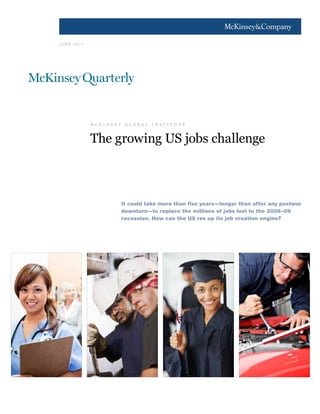The Growing US Jobs Challenge - The McKinsey Quarterly - June 2011
- 1. 1 J U N E 2 0 11 M C K I N S E Y ¬† G L O B A L ¬† I N S T I T U T E The ¬†growing ¬†US ¬†jobs ¬†challenge It could take more than five years‚ÄĒlonger than after any postwar downturn‚ÄĒto replace the millions of jobs lost to the 2008‚Äď09 recession. How can the US rev up its job creation engine?
- 2. 2 The United States ¬†faces ¬†a ¬†daunting ¬†challenge ¬†in ¬†creating ¬†jobs: ¬†at ¬†current ¬†rates, ¬†it ¬†will ¬† take ¬†until ¬†2016 ¬†to ¬†replace ¬†the ¬†7 ¬†million ¬†of ¬†them ¬†lost ¬†during ¬†the ¬†2008‚Äď09 ¬†recession. ¬†To ¬† million ¬†Americans ¬†expected ¬†to ¬†enter ¬†the ¬†labor ¬†force ¬†this ¬†decade‚ÄĒthe ¬†US ¬†economy ¬†must ¬† create ¬†21 ¬†million ¬†jobs ¬†by ¬†2020. ¬† Only ¬†under ¬†the ¬†most ¬†optimistic ¬†of ¬†three ¬†scenarios ¬†that ¬†the ¬†McKinsey ¬†Global ¬†Institute ¬† modeled ¬†would ¬†this ¬†be ¬†likely ¬†to ¬†occur, ¬†according ¬†to ¬†a ¬†new ¬†MGI ¬†report, ¬†An ¬†economy ¬†that ¬† works: ¬†Job ¬†creation ¬†and ¬†America‚Äôs ¬†future. ¬†The ¬†study ¬†sheds ¬†new ¬†light ¬†on ¬†how ¬†companies ¬† use ¬†labor, ¬†where ¬†new ¬†jobs ¬†are ¬†likely ¬†to ¬†come ¬†from, ¬†and ¬†what ¬†conditions ¬†are ¬†needed ¬†to ¬† ensure ¬†that ¬†they ¬†can ¬†be ¬†created ¬†in ¬†a ¬†sustainable ¬†way. ¬†In ¬†addition ¬†to ¬†original ¬†research ¬† and ¬†scenario ¬†analysis, ¬†the ¬†report ¬†draws ¬†on ¬†a ¬†survey ¬†of ¬†2,000 ¬†business ¬†leaders, ¬†as ¬†well ¬†as ¬† interviews ¬†with ¬†more ¬†than ¬†100 ¬†business ¬†executives, ¬†public-¬≠sector ¬†leaders, ¬†educators, ¬†and ¬† other ¬†experts ¬†on ¬†US ¬†labor ¬†markets. ¬† ¬† The ¬†United ¬†States ¬†has ¬†suffered ¬†from ¬†increasingly ¬†lengthy ¬†‚Äújobless ¬†recoveries‚ÄĚ ¬†following ¬† months ¬†after ¬†GDP ¬†rebounded ¬†for ¬†employment ¬†to ¬†recover. ¬†But ¬†after ¬†the ¬†1990‚Äď91 ¬†and ¬†2001 ¬† more ¬†than ¬†60 ¬†months ¬†will ¬†be ¬†needed ¬†to ¬†replace ¬†the ¬†jobs ¬†lost ¬†in ¬†the ¬†2008‚Äď09 ¬†recession ¬† (exhibit). this ¬†decade: ¬†health ¬†care, ¬†business ¬†services, ¬†leisure ¬†and ¬†hospitality, ¬†construction, ¬† the ¬†total ¬†number ¬†of ¬†jobs ¬†generated. ¬†Business ¬†services, ¬†for ¬†example, ¬†could ¬†create ¬†as ¬†many ¬† without ¬†high ¬†school ¬†diplomas ¬†than ¬†employers ¬†can ¬†use. that ¬†employers ¬†say ¬†they ¬†require. ¬†In ¬†our ¬†survey, ¬†40 ¬†percent ¬†of ¬†the ¬†executives ¬†whose ¬† nuclear ¬†technicians, ¬†and ¬†nursing ¬†aides, ¬†employers ¬†say. ¬†
- 3. employment ¬†levels ¬†but ¬†also ¬†open ¬†up ¬†opportunities. ¬†Broadband ¬†communications ¬† and ¬†advanced ¬†IT ¬†systems ¬†make ¬†it ¬†possible ¬†to ¬†disaggregate ¬†jobs ¬†into ¬†tasks ¬†that ¬†can ¬† be ¬†reassigned ¬†to ¬†other ¬†workers ¬†in ¬†a ¬†given ¬†location ¬†or ¬†elsewhere. ¬†Some ¬†work ¬†now ¬† performed ¬†by ¬†physicians, ¬†for ¬†example, ¬†can ¬†be ¬†handed ¬†off ¬†to ¬†physician ¬†assistants ¬†or ¬†nurse ¬† practitioners, ¬†creating ¬†demand ¬†for ¬†those ¬†middle-¬≠income ¬†positions. ¬†Also, ¬†this ¬†approach ¬† makes ¬†it ¬†easier ¬†to ¬†‚Äúonshore‚ÄĚ ¬†service ¬†jobs ¬†to ¬†low-¬≠cost ¬†US ¬†locations ¬†or ¬†even ¬†to ¬†workers ¬†in ¬† their ¬†own ¬†homes. Exhibit Jobless recoveries: it used to take roughly six months for US employment to recover after recessions, but in recent ones that time span has increased dramatically. Longer . . . Months elapsed between return of real GDP to prerecession peak and return of employment to prerecession peak1 1948 6 . . . and deeper 1953 7 % decline in employment from prerecession peak, in months since recession began 0 12 24 36 48 1957 6 1960 6 Previous recessions 1969 8 1973 3 2008 recession Lowest point: 6.34% 1981 6 1990 15 2001 39 2008 >60 months Projection, based on recent rates of job creation 1Returns ¬†to ¬†prerecession ¬†peaks ¬†are ¬†established ¬†by ¬†start ¬†of ¬†more ¬†than ¬†1 ¬†quarter ¬†above ¬†prerecession ¬†levels;Õĺ ¬†US ¬†recessions ¬†are ¬† labeled ¬†by ¬†beginning ¬†year, ¬†with ¬†the ¬†exception ¬†of ¬†the ¬†most ¬†recent. ¬†The ¬†National ¬†Bureau ¬†of ¬†Economic ¬†Research ¬†estimates ¬† that ¬†the ¬†current ¬†recession ¬†began ¬†in ¬†Dec ¬†2007. ¬†GDP ¬†returned ¬†to ¬†its ¬†prerecession ¬†peak ¬†in ¬†Dec ¬†2010. ¬† Source: ¬†US ¬†Bureau ¬†of ¬†Economic ¬†Analysis;Õĺ ¬†US ¬†Bureau ¬†of ¬†Labor ¬†Statistics;Õĺ ¬†McKinsey ¬†Global ¬†Institute
- 4. 4 Related thinking The ¬†United ¬†States ¬†will ¬†not ¬†return ¬†to ¬†full ¬†employment ¬†by ¬†following ¬†a ¬†business-¬≠as-¬≠usual ¬† ‚ÄúTranslating innovation into meet ¬†the ¬†jobs ¬†challenge, ¬†business ¬†and ¬†government ¬†leaders‚ÄĒand ¬†workers, ¬†too‚ÄĒmust ¬†attack ¬† US growth: An advanced- industries perspective‚ÄĚ the ¬†obstacles ¬†to ¬†employment ¬†and ¬†have ¬†the ¬†courage ¬†to ¬†consider ¬†new ¬†approaches. ¬† ‚ÄúWhy US productivity can grow without killing jobs‚ÄĚ ‚ÄúHow US multinationals drive economic growth‚ÄĚ way ¬†to ¬†growth ¬†by ¬†making ¬†compliance ¬†with ¬†regulations ¬†less ¬†onerous. ¬† ‚ÄúThe economic cost of the Read ¬†the ¬†executive ¬†summary ¬†or ¬†download ¬†the ¬†full ¬†report ¬†on ¬†the ¬†McKinsey ¬†& ¬†Company ¬† US education gap‚ÄĚ Web ¬†site. Copyright ¬© 2011 McKinsey & Company. All rights reserved.




